The Explosive Growth of Padel in London: A Deep Dive
London’s urban sports landscape is undergoing a remarkable transformation, with the rapid rise of padel taking center stage. This racquet sport, often described as a mix between tennis and squash, has captured the city’s imagination and is expanding at an unprecedented rate.
The Current State of Padel in London
As of June 2025, London boasts an impressive 166 padel courts spread across 42 different venues. This substantial infrastructure has emerged in a relatively short time, signaling the sport’s explosive popularity. The distribution of courts includes 73 indoor or covered courts and 93 outdoor courts, highlighting the need for all-weather play options in the UK’s variable climate.
Padel Powerhouses and Key Venues
Several venues stand out as padel powerhouses in the capital:
1. Rocket Padel Ilford: 12 indoor courts, including two singles courts
2. Rocks Lane Chiswick: 12 courts (4 indoor, 8 outdoor)
3. Social Sports Society, Brent Cross: 10 courts
4. Stratford Padel Club: 9 courts, known for high-level competitive play
Other notable venues include Padel Social Club in Earl’s Court, described as the “Soho House of Padel,” and courts integrated into prestigious private members’ clubs like Hurlingham Club and Herbert Club Chelsea.
The Economics of Padel in London
The pricing landscape for padel in London reflects its diverse offerings:
– Public park venues: £25-£30 per hour
– Premium clubs: £50+ per hour
– Hybrid models: £20-£35 per hour for pay-as-you-play, with discounted rates for members
The highest recorded price is £100 per hour at Padium’s Center Court in Canary Wharf, while the lowest is £20 per hour at Playtime Padel Club in Kingston.
Conservative estimates suggest that London’s padel courts generate over £10 million in annual booking revenue alone, demonstrating the sport’s significant economic impact.
Technology and Innovation in Padel
The padel boom in London is closely tied to technological advancements. Booking apps like Playtomic and Padel Mates are streamlining court access, while AI-enabled cameras for match recording and analysis are enhancing the player experience. The Padel World Summit 2025 in Barcelona showcased over 15 AI-related initiatives, hinting at future innovations in performance analysis, player matching, and more.
Padel’s Growth in the UK Context
London’s padel revolution is part of a broader national trend. The UK now boasts 893 padel courts across 300 venues, with a staggering 56% compound annual growth rate since 2021. This rapid expansion has positioned the UK as the fifth-largest padel market globally, with 400,000 Brits playing the sport in the past year.
Interestingly, the UK has been dubbed the world’s most social padel nation, with British players showing the highest ratio of open matches to regular bookings. This social aspect aligns perfectly with padel’s reputation for accessibility and friendliness.
Future Outlook and Challenges
Despite the impressive growth, there’s still significant room for expansion. Twelve London boroughs currently lack padel courts, presenting clear opportunities for development. The industry is particularly focused on increasing the number of indoor courts to ensure year-round play.
However, the sport faces challenges in balancing accessibility and premium offerings. Ensuring padel remains affordable and available to a broad demographic will be crucial for sustaining growth and nurturing talent across all levels of society.
5 Key Takeaways
1. London’s padel scene is booming, with 166 courts across 42 venues and growing rapidly.
2. The UK is now the fifth-largest padel market globally, with a 56% compound annual growth rate since 2021.
3. Technology, particularly booking apps and AI innovations, is playing a crucial role in padel’s expansion.
4. The pricing landscape for padel in London is diverse, ranging from £20 to £100 per hour, catering to various market segments.
5. While growth is impressive, challenges remain in ensuring accessibility and developing more indoor courts for year-round play.
To listen to the show:
To listen to The Joy of Padel podcast, you can use the embedded player above, or go find it on Spotify, Apple Podcasts or any number of other podcasting services listed here.
Send in your questions or reactions:
Please send me your questions — as an audio file if you’d like — to nminterdial@gmail.com. Otherwise, below, you’ll find the show notes and, of course, you are invited to comment. If you liked the podcast, please take a moment to review and/or rate it! ¡VAMOS!
Further resources for The Joy of Padel:

The Joy of Padel podcast, hosted by Minter Dial, a padel tennis player since 1974, and powered by Pango Sports, is an exhilarating show that delves into the captivating stories of notable padel personalities worldwide.
Meanwhile, you can find Minter's other Evergreen podcasts, entitled The Minter Dialogue Show (in English and French) in this podcast tab, on Spotify, Megaphone or via Apple Podcasts.

About the host: Minter Dial
Minter Dial is an international professional speaker, author & consultant on Leadership, Branding and Transformation. His involvement in sports has been a lifetime passion. Besides playing 18 years of rugby, captaining athletics teams, coaching tennis and playing squash for his university, he’s been a lifelong player of padel tennis, starting at the age of 10, from the time of its very first public courts at the Marbella Club in 1974.
Then, after a successful international career at L’Oréal, Minter Dial returned to his entrepreneurial roots and has spent the last twelve years helping senior management teams and Boards to adapt to the new exigencies of the digitally enhanced marketplace. He has worked with world-class organisations to help activate their brand strategies, and figure out how best to integrate new technologies, digital tools, devices and platforms. Above all, Minter works to catalyse a change in mindset and dial up transformation. Minter received his BA in Trilingual Literature from Yale University (1987) and gained his MBA at INSEAD, Fontainebleau (1993). He’s author of four award-winning books, including Heartificial Empathy 2nd edition (2023), You Lead (Kogan Page 2021), co-author of Futureproof (Pearson 2017); and author of The Last Ring Home (Myndset Press 2016), a book and documentary film, both of which have won awards and critical acclaim.
It’s easy to inquire about booking Minter Dial here.
Full transcript of interview via Flowsend.ai
This transcription comes courtesy of Flowsend.ai, an AI service for podcasters.
Pat: Okay, let’s unpack this. If you’ve been anywhere near, you know, a park, a sports club, maybe even just browsing local news in London recently, you can practically taste the energy. There’s this distinct sound cutting through the usual city noise. That sharp crack of a padel ball. Yeah, that pop, the racket, the satisfying thud against the glass walls. It’s. Well, it’s not just a newspaper showing up.
Joy: No, definitely not.
Pat: It really feels like a phenomenon, almost a revolution sweeping through the city at lightning.
Joy: It absolutely does. What began as something you might, you know, only find in a handful of places.
Pat: Right.
Joy: Is now rapidly establishing itself as a core part of London’s urban sports landscape. You see courts emerging in, well, unexpected locations sometimes. And the sheer buzz surrounding it is just undeniable. Players are scrambling for court time, communities are forming. And there’s a real palpable sense of excitement about this sport.
Pat: Exactly. And that palpable excitement, that explosive growth, is precisely what we’re diving into today.
Joy: Good stuff.
Pat: This is a deep dive into the incredible, almost dizzying rise of Padel, specifically within Greater London.
Joy: Right.
Pat: But we also want to place it firmly within the broader context of what’s happening across the UK as a whole.
Joy: Makes sense.
Pat: We’re going to peel back the layers, look at the raw data, the crucial insights and the observations from a stack of material we’ve been meticulously analyzing.
Joy: And our guide through this deep dive is someone. Well, someone uniquely positioned to understand the pulse of the Padel world. We’re drawing heavily from a comprehensive survey and detailed reports specifically analyzing the London Padel scene. And these were authored by Minter Dial.
Pat: Okay.
Joy: Now, Minter is not just an observer. He’s deeply embedded in the sport. He’s the insightful host of the Joy of Padel podcast, where he explores the culture and passion driving Padel forward. And he’s also the co founder of Pango. Yeah, it’s an innovative new padel app for players, apparently launching in autumn 2025.
Pat: Oh, interesting.
Joy: So, we’re essentially exploring the landscape through the lens of someone who really lives and breathes this sport, both, you know, from a community perspective and a commercial one.
Pat: Right. So, we’re here to unpack his findings, his data, to get a true picture of what this Pedel boom actually looks like on the ground in London.
Joy: Let’s do it.
Pat: Our mission today is. Well, it’s ambitious but clear. We want to truly grasp the sheer scale of this growth. How many courts, how many venues?
Joy: The big numbers.
Pat: Exactly. We want to figure out where these courts are Most concentrated across the city. Are there clear petal hotspots emerging? We need to identify areas that are sort of ripe for future development. Where’s the growth likely hitting? Next important question, we’ll dive into the landscape of clubs and critically how you actually get on a court. Looking at the whole digital booking ecosystem.
Joy: Right.
Pat: The practicalities, we’ll touch on the economics that are fueling this rapid expansion and finally understand how London’s pedal revolution fits into the overall equally impressive picture for the UK as a whole.
Joy: It’s an incredibly dynamic picture, you know, and the data provides a really detailed snapshot of a sport that isn’t just growing. It feels like it’s accelerating.
Pat: Yeah, it really does.
Joy: So, let’s begin by looking at those raw numbers for London.
Pat: Absolutely. So, let’s start with the headline figure as of June 2025, based on the data in these sources. What’s the number that just screams Pedell has arrived in London?
Joy: The headline figure, the one that really encapsulates the scale of what’s happening, is 166.
Pat: 166.
Joy: There are now 166 pedel courts operating within the boundaries of Greater London.
Pat: 166 courts, that is. Wow. That’s a substantial number by any measure for a sport that felt relatively new, just what a few years ago it is.
Joy: And importantly, this isn’t just one or two massive complexes skewing the numbers.
Pat: Right.
Joy: These 166 courts are spread across 42 different venues throughout the city.
Pat: 42 venues?
Joy: Yeah. And that doesn’t even count the private courts people might have built at home, you know.
Pat: Ah, yeah, the home courts, which are.
Joy: Also increasing, but they’re not part of this public or club based infrastructure count.
Pat: We’re looking at 42 different places you can pick up a racket and play padel in London. That really shows how duckly the sport is embedding itself, doesn’t it? Across different communities, different areas.
Joy: Definitely. London genuinely has caught padel fever. And these numbers really underscore that this is far from some fleeting trend. They are, as Minterdial emphasizes in the material, pretty staggering figures, particularly when you consider the pace, the speed at which this infrastructure has been built out.
Pat: Okay. Now, living in London or anywhere in the UK really, weather is always a factor, isn’t it? Especially for outdoor sports.
Joy: Always.
Pat: The sources provide a critical breakdown of the indoor versus outdoor court split. What does that look like right now?
Joy: So, the current split is 73 indoor or covered courts compared to 93 outdoor courts.
Pat: 93 outdoor. Okay, So, slightly more Outdoor courts at the moment. Let’s put that in percentage terms just to really see the balance.
Joy: Yeah, yeah. That translates to approximately 44% of the courts being indoor or covered.
Pat: Right? 44%.
Joy: And the remaining 56% being outdoor.
Pat: 56% outdoor. Given our climate, that immediately brings up a pretty significant point about consistent playability throughout the year, doesn’t it?
Joy: It really does. And Minjorda is quite, well, quite pointed about this observation in the sources. He notes that playing Padel on wet, slippery courts with, you know, wet walls that don’t give you the correct rebound and it’s just not a good experience. The reliance on wall bounces is So, fundamental to Padel.
Pat: Totally. It’s half the game.
Joy: Exactly. And rain just completely changes the dynamics, the feel and frankly the enjoyment of the game.
Pat: Yeah, that strategic use of the walls is half the fun and, well, the complexity of Padel, you lose that.
Joy: Precisely. So, based on his experience and understanding of the game in the UK climate, his personal view, his druthers, as the.
Pat: Source puts it, his brother’s a guy.
Joy: Is that for truly effective year round play, the balance should ideally be closer to 75% indoor facilities and just 25% outdoor.
Pat: Wow, 75% indoor. That’s a dramatic difference, isn’t it, compared to the current 4,456 split?
Joy: Huge difference.
Pat: It starkly highlights one of the most significant areas for future investment and development in London, that sort of urgent need for more covered facilities to guarantee consistent play whatever the weather decides to do.
Joy: It points to the fact that while the sheer number of courts is impressive.
Pat: Yeah.
Joy: The effective playing capacity, particularly during this, you know, the non summer months, is heavily constrained by that outdoor majority.
Pat: Right. Makes total sense.
Joy: The demand is clearly there, the courts are being built. But shifting that indoor outdoor ratio, that’s going to be crucial for sustaining player engagement and frankly growing the sport’s presence through all seasons.
Pat: That’s a really critical insight. It’s not just about the count, it’s about the type of court available. Okay, So, with 166 courts spread across 42 venues, where are they most concentrated? Are there specific venues or locations leading the pack? You know, the ones with the most courts? The sources aptly describe these as the Padel powerhouses.
Joy: Yes, there are definitely a few venues that stand out acting as these major hubs for Padel activity. Leading the count are two locations, both boasting an impressive 12 quarts each.
Pat: Twelve courts at a single location, that’s pretty substantial. Where are these powerhouses?
Joy: The first is Rocket Piddell. Ilford, situated in the IG1 postcode. That’s in the borough of Redbridge. And what’s particularly notable about this venue is that all 12 of its courts.
Pat: Are indoor, all indoor. Wow.
Joy: Yes. Which aligns perfectly with that desire for guaranteed all weather play we were just talking about. It even includes two dedicated singles courts, which is interesting. That format seems to be gaining traction alongside the standard doubles courts.
Pat: All indoor courts. That’s a smart move, isn’t it? Directly addressing that climate challenge.
Joy: Precisely. The second powerhouse is Rocks Lane Chiswick, located in the W4 area. That’s west London Chiswick.
Pat: Okay.
Joy: This venue also offers 12 courts, but it’s a mix. Four are indoor and eight are outdoor.
Pat: Ah, okay, a mix there.
Joy: And they also include one singles court in their setup.
Pat: So, Rocks Lane Chiswick has the joint highest total court count. But Rocket Padell Ilford currently holds the title for the most indoor courts at a single London venue.
Joy: That’s correct. Just slightly behind these two leaders, you’ve got Social Sports Society, Brent Cross in NW4. They offer 10 courts, making it another really significant hub.
Pat: 10 quartz. Yeah.
Joy: And rounding out the top tier of venues is Stratford pidel club in E15 with nine courts.
Pat: Stratford Pidel Club, right near the Queen Elizabeth Olympic Park. That whole area’s seen massive regeneration, hasn’t it?
Joy: It really has.
Pat: And Paidel feels like a very modern, dynamic sport to be located there. Fits the bill.
Joy: It fits the vibe perfectly. Yeah. Stratford Padel Club is also highlighted in the sources as having a bit of a reputation for high level competitive play.
Pat: Oh really?
Joy: Apparently they even have a system where players might need to be evaluated by a certified coach to determine their playing level.
Pat: Interesting.
Joy: It suggests a focus on developing serious players alongside, you know, just providing facilities for general play.
Pat: That’s definitely a sign of a sport developing structure and pathways, isn’t it? Not just purely recreational fun.
Joy: Yeah.
Pat: Okay, So, beyond individual venues, are there specific operators who are building out the most courts across London, controlling multiple sites?
Joy: Yeah. When you look at the operators running multiple venues, Rocket Padel emerges as the current leader in London by total court count. Rocket Padel again, they operate 21 courts across their London sites.
Pat: 21 courts. And you mentioned earlier, all of Rocket Padel’s London courts are indoor.
Joy: Yes, that’s their strategic focus in the London market. According to the sources, directly addressing the weather challenge.
Pat: Makes sense.
Joy: Minter Dial even mentioned that he had Rocket’s co founder Seb Gordon on the Joy of Padel podcast.
Pat: Oh, right.
Joy: Which probably provides some valuable insight into their expansion Strategy and philosophy. Another significant operator is game four padel.
Pat: Game four padel. Okay.
Joy: They run five clubs in Greater London with a total of 18 courts. Their portfolio includes a mix, though five of those courts are indoor or covered.
Pat: So, Rocket Padel is leaning heavily into the indoor market, while Game four Padel has a more diversified approach with a mix of indoor and outdoor courts.
Joy: Exactly. These different strategies kind of reflect how operators are positioning themselves to capture different segments of this growing market.
Pat: Let’s talk about court density. How does the number of courts stack up against the population in different areas? The sources provide a couple of really interesting examples that illustrate a key point.
Joy: Yeah. This is where the data reveal some fascinating nuances. If you use Redbridge, the borough where Rocket Padel Ilford is located, as an example, it has roughly 310,000 residents. Just having that one mega venue with 12 courts gives Redbridge a density of about 3.9 courts per hundred thousand residents just from that single club.
Pat: Right. So, that one big club makes a notable impact on the borough’s density figure.
Joy: It’s a solid baseline contribution from one location. Yeah.
Pat: Okay, So, how does that compare elsewhere? What about Hammersmith and Fulham?
Joy: Right. Now, if you look at Hammersmith and Fulham, the borough where Minter Dial actually lives, the density appears much higher on paper. Including both public and private club courts, Hammersmith and Fulham has a relatively Robust density of 8.1 quarts per 100,000 residents.
Pat: 8.1. Wow.
Joy: The sources note this is actually the highest density anywhere in London.
Pat: So, Hammersmith and Fulham has significantly more courts per capita. Than Redbridge. Yeah. That should make it much easier to book a court there. Right. More supply relative to the number of people.
Joy: And this is where that crucial sort of counterintuitive nuance comes in. It links right back to our earlier point about indoor versus outdoor.
Pat: Ah, I see where this is going.
Joy: Despite having the highest court density on paper, 12 of the 15 padel courts in Hammersmith and Fulham are outdoors.
Pat: 12 out of 15 are outdoor.
Joy: Ah, the weather strikes again.
Pat: Precisely. This fact dramatically reduces the effective availability of courts, particularly during large parts of the year in London.
Joy: Yeah.
Pat: Think about it. If it’s raining heavily or even just damp, those 12 outdoor courts might be unplayable or at best, significantly less enjoyable.
Joy: So, while the raw number looks high, players seeking consistent weatherproof padel in Hammersmith and Fulham are effectively competing for only three indoor courts.
Pat: That’s a massive difference in practical availability, isn’t it?
Joy: Yeah.
Pat: It means that density figure alone can be quite misleading.
Joy: Absolutely.
Pat: You have to consider the type of.
Joy: Court it just underscores. Munter Dial’s point that indoor courts are really the reliable gold standard for a consistent playing experience in the UK climate.
Pat: Yeah.
Joy: High density figures in areas reliant on outdoor facilities might actually mask real challenges in getting court time, especially, especially when the weather turns poor.
Pat: Right.
Joy: It also highlights areas where future indoor investment would likely have a really significant impact on meeting true player demand.
Pat: Fascinating how the data reveals those hidden challenges behind the headline numbers. Okay, let’s talk about actually getting on one of these courts. Padel seems to have landed firmly in the digital age, hasn’t it? With pay and play models really facilitated.
Joy: By technology, it really has the ability to easily find, book, and crucially, pay for courts via apps. That’s been a major enabler of Padel’s rapid growth. It aligns perfectly with modern consumer habits. You know, people expect that convenience.
Pat: Totally. So, which apps are currently dominating the booking landscape in London? Based on the sources, who’s winning the app war?
Joy: Well, Playtomic is identified as the leading booking system in London. It’s described as the winner here, at least for now. It powers reservations for 12 different venues across the city, which accounts for about one third of all the Padel locations listed.
Pat: A third of venues. That’s significant.
Joy: Yeah. And Platomac is a massive platform globally, used by over 6,000 clubs worldwide, apparently.
Pat: So, it’s a major international player with a strong foothold here in London. But you mentioned, at least for now, are there signs of a competitive market? Is it shifting?
Joy: Yes, the sources do note that despite its dominance, Playtomic has reportedly lost some key London clients.
Pat: Oh, interesting.
Joy: Including some Rocket Padel locations, for example. They’ve also seen major clubs in places like Paris, like Casa Pidel, move away from their platform. So, it suggests the booking platform market is definitely competitive and clubs are actively evaluating their options. It’s not a done deal.
Pat: Who else is competing in this space in London, then? Who are the other contenders?
Joy: Machi is another significant player serving eight clubs in London.
Pat: Macchi M A T C H I.
Joy: That’s the one. And Patel Mates is highlighted as the up and comer in the London market.
Pat: Pedal Mates. Okay.
Joy: It currently handles six venues and that number is apparently set to increase to 7 when the premium Padium venue in Canary Wharf switches over to their system in July.
Pat: Ah, So, Padium’s moving to Padelmates. That’s a signal.
Joy: Seems like it. Additionally, the David Lloyd chain, which has four Padel locations in London, they’re big health clubs. They use their own exclusive app just for member bookings.
Pat: Makes sense. And I’m sure there are clubs still just doing things their own way, using their own websites or systems.
Joy: Absolutely. The sources mentioned that some venues continue to use their own websites or private systems or other integrated club management systems. Things like the club system, private, the Virgin Active app, allstar app, Mode Club app, or the parksports website for their specific sites. Okay, So, while Playtomic is dominant, the market is definitely far from monolithic. There’s a real mix.
Pat: This focus on apps and booking platforms points to a broader trend, doesn’t it? Technology shaping the whole Padel experience. You attended the Padel World Summit 2025 in Barcelona? According to the source context?
Joy: It is, yes.
Pat: What did that reveal about the technological future of the sport beyond just booking a court?
Joy: Well, the PWS was a clear signal that the Padel world isn’t just building courts. It’s actively attracting significant investment into innovation across many areas. It’s really about enhancing every aspect of the player experience and the club experience too, through technology.
Pat: What kind of innovation were they showcasing there? What caught your eye?
Joy: A major theme was artificial intelligence. AI.
Pat: AI in Padel?
Joy: Yes. The sources specifically highlight that over 15 initiatives presented at the PWS directly involved AI technology.
Pat: 15? Wow.
Joy: And this isn’t just theoretical stuff. It’s being integrated into real world applications.
Pat: Okay, So, AI in Padel.
Joy: Yeah.
Pat: What does that actually look like on the court or in the club? How does it manifest?
Joy: Well, it can take many forms. We’re seeing things like AI enabled cameras that can record, stream and even automatically edit match footage. This allows players to review their games, share highlights easily. Stratford Padel Club, for instance, apparently offers this already.
Pat: Ah, So, like instant replays or analysis?
Joy: Kind of, yeah. Other applications could involve AI assisting with performance analysis, tracking player movements, shot selections, that sort of thing.
Pat: Right.
Joy: Or even optimizing court scheduling and matching players based on their skill level and availability. Finding you the right game.
Pat: That makes sense.
Joy: Minter Dial even mentioned that the banner image for his report was created using OpenArt AI, a personalized AI tool. Yeah, it just shows how AI is becoming integrated into the sports ecosystem, even in things like content creation and marketing.
Pat: So, technology is moving beyond just getting you on the court and into analyzing your game, potentially helping you improve, finding partners. That’s a fascinating layer of innovation coming in.
Joy: It really shows that the investment isn’t just in concrete and glass, you know, it’s also in building this sophisticated digital layer around the sport. And that’s likely to be a key driver for an engagement moving forward, I think.
Pat: Okay, let’s take that map of London and overlay where these 166 courts are actually located. The sources explain that the distribution is quite uneven across the city.
Joy: It is, yeah. The geographic distribution tells a story. It’s influenced by, you know, existing sports infrastructure, regeneration generation areas and also the target demographics of the new venues popping up.
Pat: Right.
Joy: You see different flavors of pedal scene emerging in different parts of London.
Pat: Flavors? How so?
Joy: Well, Central and West London tend to feature courts often integrated into say higher end clubs or maybe public parks. East London hosts some of the larger, more community focused hubs. North and South London offer a mix dedicated padel clubs alongside multi sport venues that have just incorporated Padel. And then areas like Canary Wharf are seeing these premium fac emerge specifically targeting, you know, the corporate population down there.
Pat: Okay, let’s begin our tour in North London then. What’s the Paidel scene looking like up.
Joy: There in North Londor? A prominent venue highlighted is the Pedell hub. North London located in Mill Hill.
Pat: The Pedal hub. Okay.
Joy: This is a dedicated indoor facility for courts and it’s highly regarded. Apparently emphasizes a welcoming community atmosphere.
Pat: Nice.
Joy: They offer essential services like racket hire, they’ve got a cafe run coaching clinics for all levels. And accessibility seems a focus too. Features like a, a step, free entrance, gender neutral restrooms, trying to be inclusive.
Pat: It sounds like a really solid community base for PID El. Any other key North London locations mentioned?
Joy: Another notable mention in North London is FG London Tennis in Camden.
Pat: Ah, Camden.
Joy: Primarily a tennis club, but they’ve added two indoor Padel courts leveraging their existing facilities. Booking is typically by appointment and they’re noted for offering expert coaching. Got a very high rating for their coaching environment.
Pat: Okay.
Joy: The sources also reference the Padel hub Whetstone with six indoor courts. Another significant facility under that same Padel hub operator umbrella in North London.
Pat: Right. So, the Padel hub is building a presence there.
Joy: Yeah. Highlighting a growing presence in that part of town.
Pat: Okay, moving east now. The sources describe East London as experiencing a genuine Padel explosion. That sounds pretty dramatic. What are the standout venues here?
Joy: East London really is home to some of the largest and arguably most impactful Padel clubs in the right now.
Pat: Okay.
Joy: Stratford Padel Club in E15, which we touched on earlier with its nine indoor courts.
Pat: Yeah.
Joy: Near the Olympic park is specifically called out as London’s largest Padel community. They boast over 20,000 registered players.
Pat: 20,000? That’s incredible.
Joy: It’s more than just courts, it’s this comprehensive facility features the AI enabled match recording and streaming. We talked about A gym bar, hot food options. It’s a real hub.
Pat: And the pricing, is it accessible?
Joy: Their pricing structure seems designed for accessibility. Yeah, they have affordable beginner packages like 15 pounds including coaching and membership for a bit. Member court hire is around six pounds an hour, non members about £10.67 an hour and a monthly membership is 22 days.
Pat: That sounds pretty reasonable, especially for London.
Joy: Yeah, and inclusivity is considered too. With ramped entrances and accessible restrooms, Trafford.
Pat: Sounds like a real destination for anyone serious about Padel in London or even just curious.
Joy: It really is designed to be a central hub, it seems also in East London, but in a completely different urban setting. You’ve got Power league Shoreditch.
Pat: Power league? Yeah, the football places.
Joy: They’ve integrated Padel into their urban football complex right near Shoreditch High street station. They offer three panoramic padel courts that actually overlook the city skyline.
Pat: Oh cool. Padel with a view.
Joy: Exactly. A unique backdrop. These are designed for convenience, often booked in 60 or 90 minute blocks. So, perfect for post work games.
Pat: Yeah, makes sense.
Joy: They offer lessons, social nights and are highlighted as a pretty affordable Central option. Around 11 pounds per person per hour.
Pat: That’s definitely appealing for that location.
Joy: It adds a unique urban flavor. We also have the newly established Rocket Padel Becton in E6 with five quarts. Another rocket Padel site, further expanding the indoor capacity in East London. And then of course there’s Padium in Canary Wharf.
Pat: Padiy, that’s the upmarket venue targeting the corporate district you mentioned.
Joy: Exactly. Paytm in E14 is described as a premium venue, eight courts, mostly indoor. It explicitly targets the professional demographic in Canary Wharf and is known for its higher price point reflecting that positioning. Okay, So, this range, you know, from community hubs like Stratford to premium venues like Padium really shows the diverse market segments Padel is reaching just within East London.
Pat: It’s quite a spread. Let’s head into central London. Now, how does Padel fit into the very heart of city? Fewer big spaces there.
Joy: Presumably in central London you tend to find padel courts integrated into existing multi sport complexes, often within those iconic green spaces like the royal parks.
Pat: Ah, okay, makes sense.
Joy: Park Sports Hyde park offers four dedicated.
Pat: Padel courts in Hyde park itself.
Joy: Yeah, it’s a publicly accessible facility where you can book online up to seven days in advance. The price around 25 pounds 80 an hour. Plus includes racket hire which is really convenient for visitors or people just starting out.
Pat: Definitely.
Joy: It’s floodlit for evening play and includes accessibility considerations too. Dog friendly cafe nearby as well.
Pat: Playing Padale in Hyde park is quite a statement, isn’t it? Very visible.
Joy: It is. And they have a sister venue, Park Sports, the Regents park with two pet El courts. Regents park, two similar setup, flood lighting, racket hire. Booking rules there allow members slightly more advanced access than the general public, but still accessible. Highly regarded for its central location and.
Pat: The court maintenance, accessing Pinal in these prime central locations is a great sign for the sport’s visibility and integration. Now moving west, it seems West London has a really interesting mix of different types of venues. Based on the earlier discussion, West London.
Joy: Is indeed a really diverse Padel landscape. You have places like Padel Social Club in Earl’s Court, right, Which is playfully described in the sources as the Soho House of Padel.
Pat: The Soho House of Padel. Okay, that paints a very clear picture.
Joy: It certainly does. It features two indoor glass backed courts within a luxurious clubhouse setting. The focus here is heavily on the social experience. Curated events, singles mixers, dog friendly stuff, champagne and cocktails available. As you’d expect from that description, it comes with premium pricing. Court hire starts at £50 an hour plus.
Pat: Right. Definitely aiming high end. What else?
Joy: In the west then you have Padel courts integrated into established, often quite exclusive private members clubs. Herbert Club, Chelsea for instance. Ah yes, Famous club offers three indoor courts as part of its racket suite for members. And members can then access the club’s extensive spa and wellness facilities. It blends high level athletic facilities with that luxury. Hospitality feels top coaches available too. Similarly, the Hurlingham Club in Fulham, another very prestigious one, a private members club set on 42 acres, has added four outdoor padel courts. State of the art courts, lovely locker rooms, riverside cafe, booking is via their private app and membership vetting is famously strict.
Pat: And wasn’t there something really unique mentioned about Hurlingham Club that speaks to the demand? Something unusual?
Joy: Yes, that’s right. The sources highlighted a truly unique example. A sumptuous floating court on the water at the Hurlingham Club.
Pat: A floating court? Seriously?
Joy: Apparently so. This was a pop up installation cited via Gareth Evans and it’s just a vivid illustration that demand is So, high operators are creating temporary, even quite spectacular facilities to meet it.
Pat: Wow.
Joy: It’s a clear sign of serious momentum and, well, creativity in the market.
Pat: A floating padel court. That’s incredible. It definitely underscores the point about demand outpacing supply sometimes. What other key venues are there in West London?
Joy: Well, Rox Lane Padel Tennis in Chiswick, which we previously mentioned, is one of the powerhouses with its 12 quarts, four indoor, eight outdoor is a major presence in West London. It’s known for being family oriented, has amenities beyond padel like soft play, youth tournaments, clubhouse cafe fosters community. Both pay as you play and membership options are available though court hire is pricier. 44 outdoor, 55 indoor per hour.
Pat: Okay, So, different vibe to Hurlingham or Pedal Social Club.
Joy: Definitely. And there’s Playtime Padel Club in Barn Elms, SW13. They offer two indoor courts and focus on professional coaching for all ages and abilities in an inclusive atmosphere. Noted for good accessibility features too.
Pat: Good to know. Moving south. Now let’s look at southeast London.
Joy: What’s happening there in Southeast London? Pedal Box Bermondsey is highlighted as a key venue. It has four indoor courts located within the British Wharf sports complex in SE15. They offer pay as you play access for non members, but better rates are available through block bookings or memberships. Standard amenities like showers, cafe, free wi fi are available and the venues noted for ground level access and reserved parking.
Pat: Sounds like a solid practical option. And southwest London seems to have quite a concentration as well.
Joy: Southwest London is definitely a busy area for Padeldale. The padel yard in Wandsworth SW18 is a significant venue the padel year. According to the main court list in the sources, it has six padel courts in total with three being indoor. The descriptive text mentions three indoor and two outdoor for five total. Plus a pickleball court.
Pat: Oh, okay. Slight discrepancy maybe.
Joy: Yeah, possibly just how things are counted. Or maybe recent changes sticking to the main list’s six total, three indoor for consistency in our overall count.
Pat: Makes sense.
Joy: This venue has a vibrant bar area, Craft beers, smoothies, coaching equipment rental, open long hours 7am to 11pm and it actively promotes social play through mixers and ladies only sessions. Good accessibility too.
Pat: A real social spot by the sounds of it. With a bar and mixers.
Joy: Yes, definitely aiming for that community vibe. Also in southwest London is the National Tennis Centre padel at Roehampton SW15.
Pat: Right at the LTA base.
Joy: Exactly.
Pat: Yeah.
Joy: This is part of the LTA’s High Performance Training Base and features three covered indoor courts. Interestingly, they’re available for public pay and play bookings.
Pat: Oh, the public can play there?
Joy: Yes. At a rate of 30 pounds per hour. Available seven days a week, bookable up to seven days ahead. It’s great that the national training facility offers public access though the sources note racket and ball rental requires registration with the LTA Advantage scheme.
Pat: Still playing where the pros train. That’s quite a unique opportunity.
Joy: Potentially, yeah. Finally, in SW London there’s Piddell people. In Wimbledon SW17, this operates just one indoor court within a hybrid fitness gym.
Pat: Only one court?
Joy: Yeah. But despite the single court, it’s described as a very community driven spot. Apparently it leverages a WhatsApp network really effectively to connect players, especially ladies groups and organize games and social media.
Pat: Ah, interesting model.
Joy: It shows that even smaller setups can build a strong dedicated player base through that kind of community focus. Member court hire is around 22 plus per hour accredited coaching available.
Pat: It’s really striking to see the sheer variety of venues across London. From these huge indoor complexes and courts in royal parks to integrated courts and gyms, private clubs and then these fascinating pop up locations like that floating court.
Joy: That emergence of temporary or pop up courts is a really compelling indicator, isn’t it? Yeah, venues like Pidel Affair which had a pop up in West London, UB2 and previously even at Marble Arch and that floating court at the Hurlingham club, they are clear signals that the demand for Padel is currently outstripping the supply of permanent courts in some areas or for certain events.
Pat: Right.
Joy: When the market is supporting creative, sometimes complex temporary solutions like that, you know, the underlying momentum is really serious.
Pat: That leads us nicely into the economics then. With all these courts and different types of venues, what does the pricing landscape actually look like across London? Is it expensive to play?
Joy: Well, London’s pedal pricing definitely reflects the rapid commercialization and the diverse types of facilities available. The sources categorize it broadly into three main areas.
Pat: Okay, what are they?
Joy: First, you’ve got your public park pay as you go options. Second, the pricing associated with those exclusive private members clubs. And third, hybrid models that mix membership benefits with pay per play rates.
Pat: Right. Can you give us some examples of the actual price ranges? What are we talking cost wise?
Joy: Okay, So, at the more accessible end, public park venues like the park sports locations and Hyde park and Regent’s park typically charge between 25 and 30 pounds per hour for a court.
Pat: 25 to 30 pounds an hour?
Joy: Yeah, and online registration is usually free, allowing you to book courts in advance. Racket hire often included too.
Pat: As we said, that seems quite reasonable, especially for a central London location like Hyde Park. What about the premium end, the Soho House of Padel?
Joy: Right. At the top tier are the rates you’d encounter at those boutique or private members clubs. Padel Social Club, Harbor Club Chelsea, the Hurlingham Club. Padel access here is often just one part of a broader, sometimes quite substantial membership fee. So, the effective cost per hour when you factor in the membership investment can be significantly higher. Well above 50 pounds per hour isn’t unusual.
Pat: Okay.
Joy: Padel Social Club in Earl’s Court specifically lists its court hire starting at 50 pounds per hour, which aligns with its luxury positioning.
Pat: Got it. And the hybrid model sitting in between.
Joy: Exactly. Hybrid operators like the Padel Hub North London or Padel Box Bermondsey offer more flex flexible options. Their walk in or standard pay as you play rates are typically in the 20 pound to 35 town range per hour.
Pat: Okay, that’s lower.
Joy: Yeah. And then they incentivize regular playthrough membership packages that offer discounted hourly rates. So, they appeal to both casual players and the more committed ones.
Pat: What are the absolute highest and lowest prices cited in the sources? The extremes.
Joy: Okay. At the very peak, Perayam’s Center Court in Canary Wharf holds the title for the highest price point. It Commands A substantial £100 per hour.
Pat: £100 an hour?
Joy: Yep. This is for a state of the art game cam equipped court designed for a premium corporate clientele. Close behind that, the Padel Hub North London, specifically referenced as the Totteridge location in the sources for this point.
Pat: Right.
Joy: Charges £80 per hour during peak times.
Pat: £100, £80 an hour. That definitely puts Padel firmly in the luxury category for some specific courts or times.
Joy: It really shows the willingness of a certain market segment to pay for premium facilities, location and convenience. At the other end of the scale, the lowest prices are generally found in more suburban locations or during off peak hours. Playtime. Padel Clubs in Kingston is cited as offering the capital’s lowest hourly rate at £20 per hour.
Pat: £20 an hour. That’s much more accessible for a lot of people.
Joy: Definitely.
Pat: So, what do these varying price points and the emergence of different pricing models memberships pay as you go peak, off peak. Tell us about the market itself. Is it just finding its feet or something else?
Joy: The sources interpret these diverse approaches and the increasing use of discounts as signs of market maturation.
Pat: Maturation already seems so.
Joy: We’re seeing innovative pricing strategies emerge beyond just simple hourly rates. There are subscription packages like stratford, Padel Club’s 22 monthly membership. We mentioned punch card systems, specific passes for youth players. Many venues are also employing dynamic pricing, adjusting rates based on demand. Stratford, for example, lowers its off peak rate significantly for non members down to $27 an hour.
Pat: Ah, okay. Trying to fill the courts.
Joy: Exactly. This shows venues are actively trying to optimize revenue and encourage play across all times of the day. Not just relying on peak hours, but.
Pat: With such a wide price range from £20 up to £100 an hour. Does this create accessibility challenges for the sport? Is everyone able to play?
Joy: Absolutely. It highlights a significant challenge. The price disparities, especially that big difference between the premium central and the more affordable suburban ones, mean that accessibility isn’t uniform across the city or across different income levels. While the sport is booming, ensuring it’s truly accessible to people from all demographics is going to be crucial for long term sustainable growth and for building a genuinely broad player base.
Pat: Yeah, you need that wide pace.
Joy: The sources even connect this accessibility piece directly to the LTA’s ambition for Britain to develop a competitive national team, suggesting that achieving that goal requires embedding the sport affordably within youth and community programs So, you can identify and nurture talent from all backgrounds, not just those who can afford the premium clubs.
Pat: That’s a really crucial point. Growth needs to be inclusive if you want to build a deep talent pool and become truly mainstream, not just a niche high end sport.
Joy: Exactly.
Pat: So, looking ahead then, is this incredible padel boom in the UK, particularly what we’re seeing in London, showing any signs of slowing down?
Joy: Yeah.
Pat: Is there a risk of the boom, well, busting like we saw in Sweden, maybe?
Joy: That was a key question raised at the Padel World Summit in Barcelona, apparently. And the sources are very clear in their assessment, particularly Minter Dial’s analysis. Absolutely not. The prevailing sentiment is that London can comfortably absorb many more indoor courts. Emphasis on indoor again, many more.
Pat: That’s a confident prediction. So, the current growth isn’t even close to the ceiling yet?
Joy: Far from it. It seems the data highlights areas with significant untapped potential. At the time the sources were compiled, There were still 12 boroughs in Greater London that did not host a single padel court.
Pat: 12 boroughs with zero courts. That’s a massive opportunity for expansion.
Joy: Right there it is, yeah. And the sources confirmed that this situation is already changing rapidly. Multiple new venues are either under construction or have been announced as coming online soon.
Pat: Are there specific examples of planned expansions mentioned? Any big ones?
Joy: Yes. Rocket Padel, already the largest operator by court count in London.
Pat: Right.
Joy: Has plans to add another nine courts to their portfolio by late 2025 in Croydon.
Pat: Nine more courts in Croydon.
Joy: And crucially, these will all be indoor courts.
Pat: Ah.
Joy: Sticking to their strategy, directly addressing that key need we identified earlier. Several smaller venues have also been announced, including plans for courts coming soon to Haringey, for example.
Pat: So, we’re looking at a significant increase in the court count just within the next year or So, beyond the current 166.
Joy: Seems very likely, yes.
Pat: How does London’s growth rate compare or fit into the broader UK picture?
Joy: Yeah.
Pat: Is the whole country seeing this kind of boom?
Joy: London is certainly leading the charge in many ways, but it’s definitely part of a nationwide phenomenon. According to Data from the LTA, the governing body for Padel alongside tennis in the UK, there were 893 Padel courts across 300 venues in the UK at the time the sources were compiled. Just under 900 courts nationally.
Pat: Almost 900 courts across the whole of the UK now. And what’s the national growth rate looking like? How fast is that number increasing?
Joy: It’s incredibly fast. The UK has experienced a plus 56% compound annual growth rate in padel court since 2021.
Pat: 56% compound annual growth?
Joy: Yeah. That means on average the number of courts has been increasing by over 50% each year for the past few years.
Pat: That is genuinely explosive growth on a national scale. Phenomenal.
Joy: It truly is. It positions the UK as having one of the fastest padel growth rates anywhere in the world right now.
Pat: Wow.
Joy: And it’s translating into significant participation too. The LTA’s figures show that 400,000 Brits played padel at least once in the last 12 months.
Pat: 400,000 people playing padel in a year. That’s a substantial and rapidly expanding player base, isn’t it?
Joy: It really confirms the sport is moving well beyond a niche interest and into the mainstream consciousness. And there is a truly unique finding about the UK market that came out in the new global Padel report from Playtomic which was pre released at the pws.
Pat: Oh, what did that global report say specifically about the UK? Something unique.
Joy: Playtomic reported that the UK is now officially the world’s most social padel nation.
Pat: The most social padel nation? What does that mean exactly in practical terms on the court?
Joy: Well, Pablo Caro, who’s a co founder of Playtomic, clarified this. He stated that Britain has the highest ratio of open matches to regular bookings seen anywhere worldwide.
Pat: Highest ratio of open matches. So, UK players are more likely to book a court and actively look for partners or jump into games that need players rather than just sticking rigidly to their fixed group of four.
Joy: That’s exactly the implication. Yes. It suggests a particularly welcoming, open and community oriented culture among UK Padel players.
Pat: Interesting.
Joy: They seem genuinely keen to mix play with different people and grow their network on the court. More So, than in other countries, apparently.
Pat: That really aligns with the sport’s general reputation for being accessible and friendly, doesn’t it?
Joy: It really does.
Pat: And how does the UK rank Globally. Now, in terms of overall activity, where do we sit?
Joy: According to that same global Padel report by Platomic, the UK is now the fifth largest Padel market globally.
Pat: Fifth largest?
Joy: Yes, based on the sheer number of matches played. Considering that Padel has been established in many other countries like Spain or Argentina for decades, climbing to the fifth position worldwide So, quickly is a truly remarkable achievement. It just underscores the scale of the boom we’re analyzing here.
Pat: Fifth largest globally. That’s incredibly impressive. It really highlights just how significant this UK boom is on the international stage. Okay, with all this activity, these nearly 900 courts nationally, 166 in London, 400,000 players. What kind of revenue is this generating just in London alone? Is it making money?
Joy: Well, the sources provide a helpful back of the envelope estimate for the booking revenues generated just by those166.66 quarts currently operating in Greater Linden.
Pat: Okay, a rough estimate.
Joy: Yeah, taking a pretty conservative approach, assuming maybe a 40% capacity utilization rate. Meaning courts are booked 40% of the time they’re actually available.
Pat: Right.
Joy: And using an average price per hour.
Pat: Of 30 pounds, which as we saw sits nicely in the middle of that.
Joy: Price spectrum we discussed precisely with those assumptions. The estimated total booking revenue just for London’s padel courts comes out to over 10 million pounds per year.
Pat: Over 10 million pounds per year just from court hire fees in London.
Joy: Yeah, not too shabby. As the source material dryly noted, not.
Pat: Too shabby at all. It definitely demonstrates that this rapid growth isn’t just a participation story, it’s also building a significant commercial ecosystem around it.
Joy: Absolutely. It’s attracting investment and generating revenue that can then presumably further fuel expansion and development.
Pat: Okay, let’s try and connect all these dots for you, our listener. We’ve delved into the striking numbers. The 166 courts, the 42 venues we’ve looked at, the geographic spread, the rise of booking apps and tech, the varying price points from 20 to 100 pounds, and this remarkable national context that places the UK as a global leader in growth and fascinatingly social play. What does this comprehensive picture mean for you? Someone who might be curious about Padel, maybe thinking of playing, or already playing in London?
Joy: Well, what emerges from this deep dive into Minter Dial’s work, I think, is that London’s Padel scene is a truly dynamic, diverse and rapidly evolving ecosystem.
Pat: Yeah, dynamic feels like the right word.
Joy: It’s successfully balancing providing accessible options, often in public parks or those hybrid clubs, with offering really premium experiences in more exclusive venues. And all of this is increasingly powered by digital technology. From the ease of booking via apps like Playtomic or Padelma Days, to the potential future integration of AI to enhance the game itself, it serves as a fantastic case study really for how a sport can move from being relatively niche to achieving significant mainstream traction through a combination of aggressive facility expansion, developing programming for all levels beginners to advanced, and making smart investments in technology and community building.
Pat: So, why does all of this matter to you? Listening with 166 courts available right now, and that number clearly expanding rapidly, spread across 42 different venues and growing, the simple fact is there are exponentially more options than ever before to find a place to play Padel in London.
Joy: Whether you’re prioritizing the most affordable price point, you know, looking for that 20 pound court, or seeking a premium high end experience like Padium or Pedal Social Club. Or maybe you just need a court in a specific part of town. Want the certainty of indoor play regardless of the infamous London weather?
Pat: Definitely a board.
Joy: Or you’re looking for a particular community vibe, perhaps a club known for its social mixers or dedicated sessions for specific groups like ladies or beginners. The landscape is incredibly rich and varied now. The diversity in venue types, pricing models and booking systems means there is very likely an option out there that fits your needs, your preferences and your budget. But navigating this rapidly growing and diverse landscape does require understanding its contours, which is what we’ve aimed to provide today using Minters and such, right?
Pat: Consider this deep dive your essential starting point. Maybe your map to the London Padel Revolution, now that you have a clearer understanding of the scale, where the courts are concentrated, the different types of places available, the pricing, the tech layer, the next step is yours.
Joy: We’ve laid out the territory based on the extensive data and observations compiled in our source material from Minter Dial.
Pat: So, thinking about your own situation, your location in London, your budget, the kind of playing experience you’re looking for, are you focused purely on getting some exercise? Maybe aiming for more competitive play, or simply wanting a fun social activity? Based on all of that, where might you start your search for a padel court in London? Which area or type of venue feels like the best fit for your own padel journey? Now you know it’s out there.
Joy: The possibilities are expanding almost daily.
Pat: It feels like this padel revolution in London isn’t just happening, it really is accelerating.
Joy: It truly is a fascinating time for the sport in the city.
Pat: So, here is a final thought for you to take away and perhaps mull over as this incredible growth continues, fueled by both private investment in places like Canary Wharf and these hybrid community models, how will the future balance play out? The balance between ensuring widespread public accessibility across all boroughs and the continued development of those premium high end facilities can both thrive equally.
Joy: And building on that, given the explosion of interest in technology, particularly AI showcased at events like the Padel World Summit and already appearing in some London venues, what will the next wave of technological innovation truly mean for your personal experience playing Padel in London in the years to come? Yeah, will it transform coaching, matchmaking or even just how you interact with the sport on a daily basis?
Pat: Interesting questions for a sport that feels like it’s sprinting into the future. We’ve taken a deep dive into the data and insights on London’s booming Padel scene today, thanks to the comprehensive work compiled in our source material by Minter Dial.
Joy: We hope this has provided you with a well informed and engaging perspective on this really exciting phenomenon happening right across the capital.
Pat: Until our next deep dive, maybe you’ll find yourself experiencing that padel buzz firsthand on a court somewhere in the city very soon.
Joy: Enjoy discovering it for yourself.











